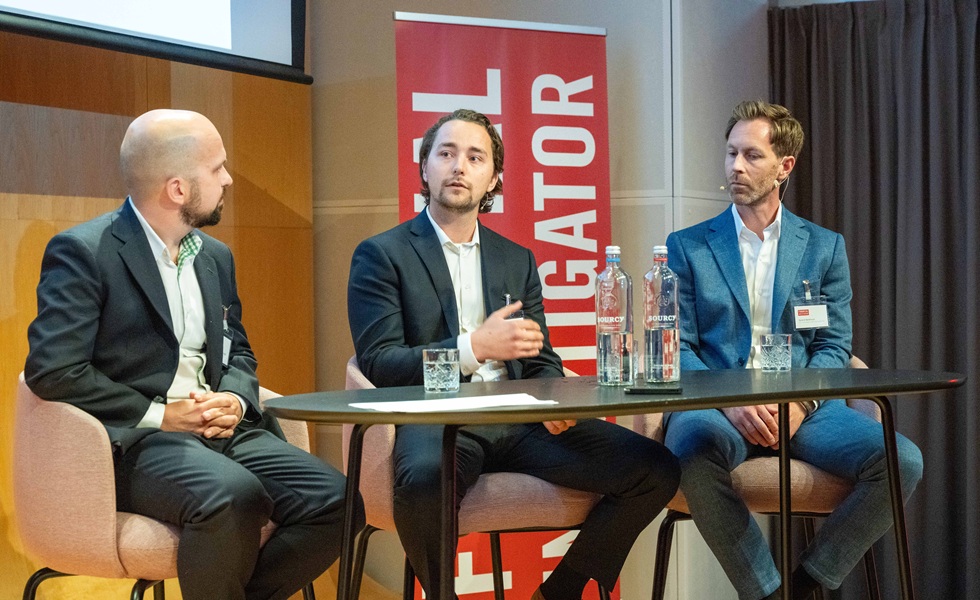Panel discussion: ‘How to create impact in green infrastructure’
Panel discussion: ‘How to create impact in green infrastructure’

This report was originally written in Dutch. This is an English translation.
Green infrastructure is rapidly gaining ground as an investment category. It is tangible, scalable and rich in potential. During a panel discussion, experts addressed the question of how investors can use it to achieve not only financial returns but also social impact – especially now that the energy transition needs to be accelerated.
By Baart Koster
|
MODERATOR: Vincent van Beijleveld, Managing Director, Global Real Estate Engagement Network (GREEN), Managing Consultant on Sustainable Investment, Finance Ideas PARTICIPANTS: Sjoerd Berkhout, Portfolio Manager, a.s.r. real assets investment partners Marco van der Geugten, Senior Portfolio Manager Infrastructure, MN Tiemen Jansen, Climate Risk Analyst, Ortec Finance |
During the closing panel discussion at the seminar “Green Infrastructure & Sustainable Real Estate” organised by Financial Investigator, Marco van der Geugten from MN, Sjoerd Berkhout from a.s.r. real assets investment partners and Tijmen Janssen from Ortec Finance take their places on stage. Chair Vincent van Bijleveld of Finance Ideas quickly moved on to the key question at the start of the debate: how can you make an impact with investments in green infrastructure? There was no ready-made answer. However, a stimulating debate ensued about opportunities, pitfalls and necessary choices. Because it is clear that there are opportunities. But how do you weigh up returns, sustainability and systemic risks in a world where even the 1.5-degree target is slipping out of sight? And how, as an investor, do you steer a strategy that is future-proof and adds social value?
From niche to building block
Green infrastructure is no longer a marginal phenomenon, but fits seamlessly with megatrends such as climate change, technological progress and social expectations. This makes it a logical core building block in an increasing number of institutional portfolios, according to Berkhout and Van der Geugten's practical experience. The scalability, visibility and tangible nature of the underlying projects also make green infrastructure attractive to managers who want to realise their sustainability ambitions in concrete terms. According to Berkhout, it's all about broad value creation. ‘We look at infrastructure from the perspective of megatrends such as ESG, climate change and digitisation. Green infrastructure plays a key role in this. In addition to renewable energy, you can think of categories such as utilities, smart meters, water infrastructure and data centres.’
Van der Geugten sees wind and solar energy in particular as having matured: ‘Solar and wind have become stable sectors with predictable returns. In addition, you see emerging areas such as battery technology and EV charging infrastructure, where the risk profile is higher, but where the growth potential is also greater.’ According to Van der Geugten, investability is increasing in these areas. But in order to capitalise on such opportunities, he believes you need to have a good understanding of the technological and regulatory ecosystem. Moreover, this attractiveness does not depend solely on stimulating policy, Janssen adds. ‘Even without further policy measures, green technologies will continue to grow, simply because they are more cost-efficient than fossil fuel alternatives.’ Janssen cites the falling cost of batteries and the total lifespan of electric vehicles, or EVs, as examples. ‘As a result, even in markets without strict legislation and regulations, a clear preference for sustainability is emerging.
The real additionality lies in technologies that are still under development. The risk is higher there, but so is the potential impact.
Impact starts with additionality
However, not every investment with a green label automatically has an impact. The concept of ‘additionality’ in particular proved to be a recurring assessment framework in the panel discussion: as an investor, are you actually adding something, or are you buying something that would have been realised anyway? Van der Geugten: ‘You make the biggest impact in the development and construction phase. That is where capital is most sorely needed. Nevertheless, pension funds often opt for operational assets with stable cash flows. We see ourselves as a capital provider: by financing existing assets, we enable developers to start new projects. This still creates a flywheel effect.' Berkhout shares this view, but warns against complacency: 'There is now sufficient capital available for solar and wind energy. The real additionality lies in technologies that are still under development. The risk is higher there, but so is the potential impact. Anyone who gets involved in this must be convinced of the direction of the transition and be prepared to stray from the beaten track.
Janssen emphasises that conviction does indeed play a major role here: ‘Investors must believe in the transition. Those who do so actively position their portfolios in emerging sectors, even if they are not yet proven. We see this willingness more often in North America than in Europe. There, parties are already investing in technologies such as carbon capture or advanced storage solutions.’ Governance also plays a role. After all, projects that are financed at an early stage involve not only technological but also legal and institutional risks. ‘As an investor, you really need to be capable of dealing with that,’ says Berkhout. ‘But at the same time, that is also the area where you, as an institutional party, can make a difference.’
Brown to green: regular strategy or extra impact?
A provocative question from the audience then leads to a brief debate about “brown to green” transformations. Is making existing infrastructure more sustainable an impactful investment, or simply part of regular ESG policy? Berkhout is clear on this: ‘Every sub-sector within infrastructure must contribute to climate goals. That makes decarbonisation a natural part of your regular strategy. But only if a fund explicitly focuses on this can you label it as impact.’ Van der Geugten confirms that specialised fund managers are focusing on this, but that decarbonisation must also be applied to existing infrastructure investments. ‘In a world with stricter regulations and CO2 pricing, this will also become increasingly important for maintaining value. Decarbonisation can also be part of broader energy transition funds. Energy generation then forms the stable basis, decarbonisation the ambitious element.’
Even without further policy measures, green technologies will continue to grow, simply because they are more cost-efficient than fossil fuel alternatives.
And what if sustainability mainly stems from market forces? Janssen places this question at the heart of his reflection on green infrastructure. ‘Green infrastructure has an impact in itself. But if greening is the logical consequence of cost optimisation – and we expect this trend to continue – then it is an attractive investment category in its own right.’
Climate risks require robust modelling
While the risk-return ratio of green infrastructure is relatively favourable, the same cannot be said for the associated climate risks. These are complex, location-specific and difficult to quantify. Nevertheless, according to Janssen, investors need to deal with them in an increasingly explicit manner. ‘We model climate scenarios top-down. This involves looking at the macroeconomic impact and translating this to sectors and investment categories. This allows you to identify systemic risks, such as the sensitivity of energy sectors to physical climate risks.’ According to Janssen, flooding in Taiwan is a good example because of the high concentration of chip production there. ‘Such scenario analyses are therefore necessary to build in stress resistance.’ Physical risks are particularly relevant for infrastructure projects, Berkhout emphasises: ‘The effect of climate change on hydroelectric power stations, for example, is often underestimated. If precipitation patterns change, yields can become unpredictable. Such risks are still far from always being priced in."
Models and data suppliers differ greatly in their outcomes. That is why the debate participants unanimously recommend a case-by-case approach. ‘Involve fund managers in the risk analysis you carry out yourself, from the selection phase to monitoring,’ adds Berkhout. ‘You have to take a critical look at every project: how has climate resilience been incorporated into the design and how flexible is the infrastructure in changing circumstances?’ It is also important to demand transparency from developers and operators, adds Van der Geugten. ‘Without proper reporting on climate risks, it remains a matter of guesswork. As an investor, you need to ask the right questions and be prepared to make choices based on them.’
Benchmark and mission
Although impact is a key objective, many investors struggle with its measurability. Unlike real estate, infrastructure often lacks a standardised framework. GRESB offers an infrastructure module, but its design is limited. This makes it difficult to compare funds. Berkhout: ‘Some funds use their own methods, whether or not based on frameworks such as SBTi, the Science Based Targets initiative. But there is a lack of uniformity. What does help is looking at the number of megawatts or gigawatts that a project generates. That at least gives a direct indication of impact. But more refinement is needed for social and environmental dimensions.’
Without proper reporting on climate risks, it remains guesswork. As an investor, you have to ask the right questions and be prepared to make choices based on them.
There is also active participation from the audience. One participant cites the example of green bonds: in theory, they would have an impact, but without a clear intention, it often remains a matter of labelling. Toyota is cited as a striking example: years ago, 20% of its investments were labelled green, without anything extra actually happening. In other words, without targeted capital investment, no real change is set in motion. The listener therefore concludes that without intention, there can never be any real impact.
Green infrastructure: not either/or, but both/and
A striking final note from the panel is that no one endorses the contradiction between return and impact. On the contrary: if you do it right, you don't have to make any concessions. Van der Geugten: 'Renewable energy offers an attractive profile: the risk-return ratio is comparable to core real estate, but with slightly higher returns and much more social value. So it is no longer a choice between return or impact. The trick is to combine both.’
Berkhout sees a shift in mindset: ‘More and more investors want not only core investments, inflation protection or diversification, but also impact. The challenge is to unite these elements within a clear strategy. This requires not only different investment criteria, but also a different approach to discussions with stakeholders and participants. Janssen concludes by pointing out the urgency: ‘Although the 1.5°C target seems increasingly difficult to achieve, investing in green infrastructure remains attractive. Even without additional policy, we expect growth in this sector. Combine that with impactful projects, and you can achieve both financial returns and social value – even without further government measures.
More than a buzzword
Among other things, the discussion makes it clear that green infrastructure is much more than a fad. It is a collective term for opportunities, dilemmas and responsibilities. Investing in renewable energy or smart grids requires not only capital, but also vision, conviction and benchmarks that go beyond returns. Impact starts with choices – and with the willingness to forge ahead, even if the path is not yet fully paved. Or, as the discussion shows, a robust approach is preferable to an exact estimate that misses the mark. In a time of structural change, green infrastructure provides the foundation for both financial and social returns – and the opportunity to make decisions now that will make a difference in the future.
|
SUMMARY Green infrastructure is growing from a niche to a core component of investment portfolios. Impact requires additionality, vision and the courage to invest in immature technologies. Brown-to-green projects offer impact provided they are explicitly embedded in strategy. Climate risks are difficult to model, but crucial for robust portfolios. Standards for impact measurement are lacking; transparency and customisation are essential. Return and impact do not have to be mutually exclusive: it can be both. |










